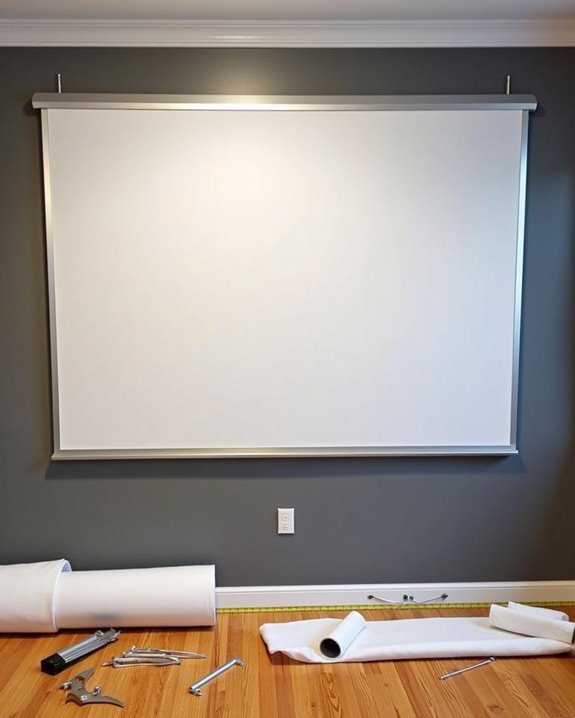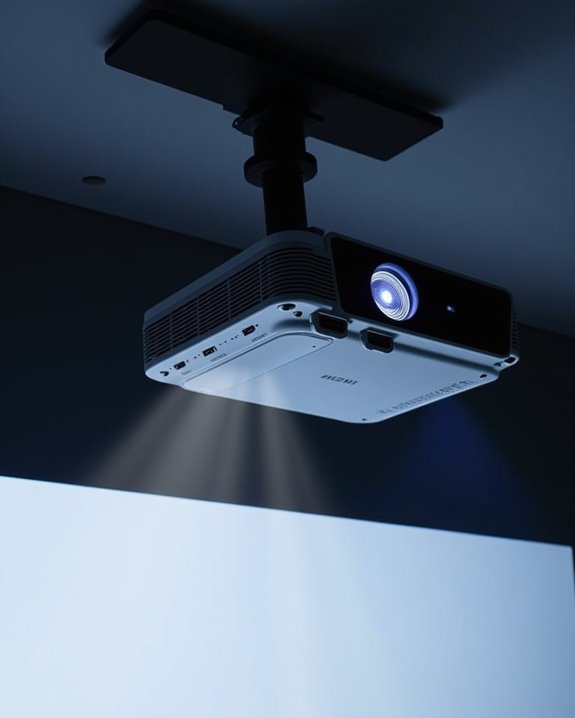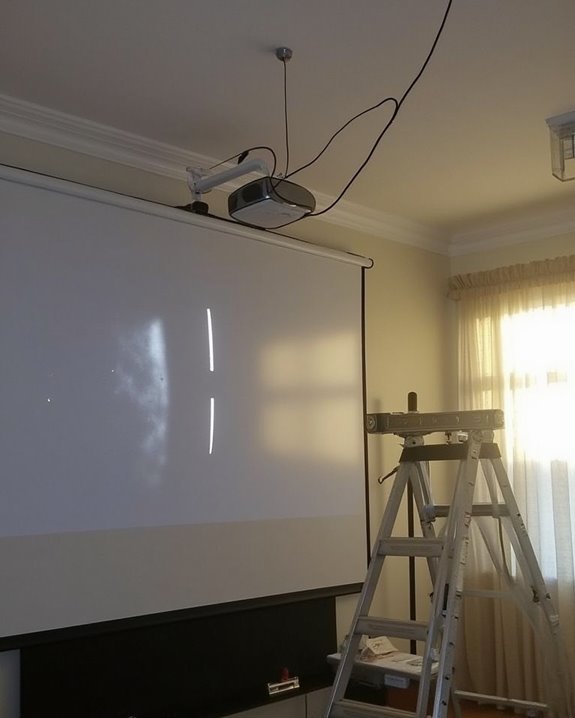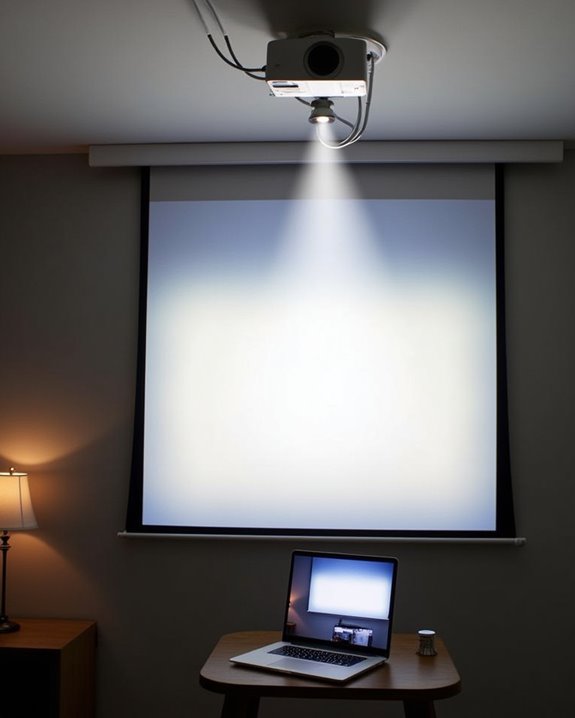You might wonder if projector paint truly performs as a substitute for traditional home theater screens, especially since manufacturers claim it enhances reflectivity, contrast, and image sharpness when applied to a smooth wall surface. This specialized paint contains reflective compounds designed to distribute projected light evenly, minimizing hotspots and boosting color accuracy, but its effectiveness often depends on ambient light control and proper wall preparation. To understand whether projector paint actually meets your home theater expectations, consider how it compares to established screen materials.
Key Takeaways
- Projector paint can effectively create a high-quality home theater screen when applied to a smooth, prepared wall.
- It offers customizable options for brightness, contrast, and glare control to suit different room conditions and projector types.
- While not as durable as traditional screens, projector paint maximizes space and adapts to various room sizes and layouts.
- High-performance projector paints enhance image clarity, reflectivity, and color accuracy for an immersive viewing experience.
- Leading brands provide projector paints with advanced features designed for 4K resolution and long-lasting home theater use.
What Is Projector Paint and How Does It Work?
If you’ve ever wondered how to turn an ordinary wall into a high-quality projection surface, projector paint offers a practical solution by providing a matte finish that enhances image clarity and brightness. Projector paint is a specialized coating designed to maximize projector performance using highly reflective particles, which boost brightness and prevent hot spots, ensuring even light distribution. Historically, such coatings were used in educational and commercial settings to create versatile, interactive displays before the rise of fixed screens. You’ll find projector paint easy to apply with a roller or spray, and it’s compatible with HD, interactive, and standard projectors. Modern projectors with high brightness capabilities can especially benefit from these paints to optimize image quality. Environmental impact is minimized, as it allows you to repurpose existing walls, reducing material waste compared to installing new screens, and it’s suitable for a wide variety of indoor environments. Additionally, projector paint comes in different finish types—such as matte, satin, or gloss—so you can select the option that best matches your room’s lighting and projection needs.
Comparing Projector Paint to Traditional Screens
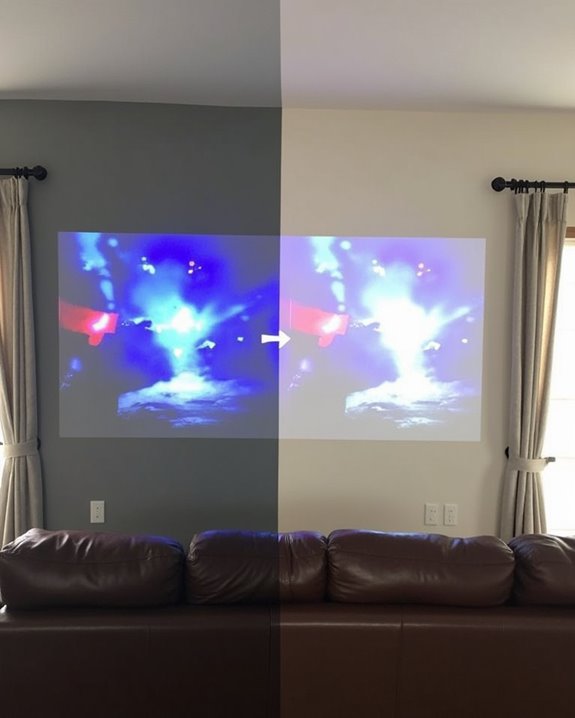
While projector paint offers a versatile solution for turning almost any wall into a projection surface, it’s important to guarantee how it stacks up against traditional projector screens across several key factors. Traditional screens are engineered to deliver high color accuracy and image clarity, thanks to specialized materials that prevent issues like hot spotting and ensure consistent brightness. In contrast, projector paint technology has improved and can now provide good reflectivity and flexibility, but it may show more variability in color accuracy and brightness. Many high-end projectors with high contrast ratios can help mitigate some of these limitations when paired with painted surfaces.
- Picture Quality: Traditional screens excel in resolution, clarity, and color accuracy, while projector paint’s performance depends on the paint type and wall preparation.
- Environmental Durability: Screens are more resilient to scratches, dirt, and humidity; paint can require frequent touch-ups. Using durable paint formulations designed for projection can extend the lifespan and maintain image quality.
- Versatility: Projector paint adapts to various surfaces, maximizing space and creative placement options.
Additionally, users should be aware that painted screens tend to be less effective in high ambient light compared to dedicated ALR screens, so controlling room lighting is crucial for optimal results.
Cost-Effectiveness and Installation Considerations
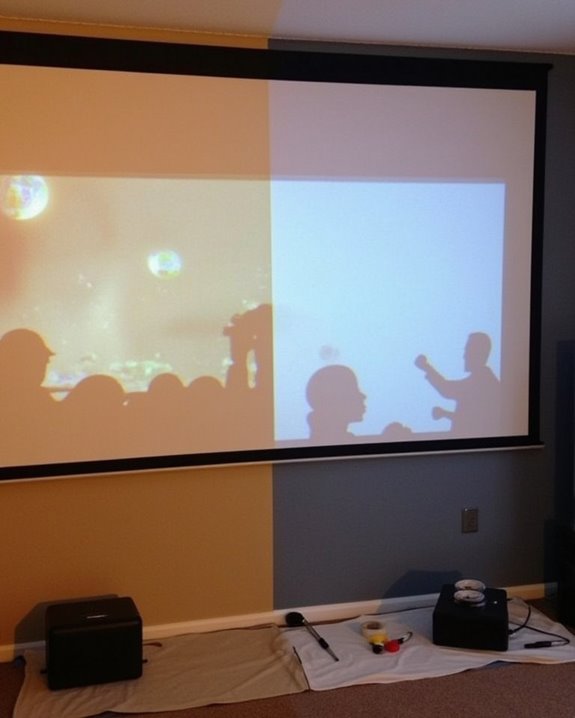
Although projector paint presents a compelling alternative to traditional screens, it’s essential to weigh both the cost-effectiveness and installation requirements before making a decision. Projector screen paint typically ranges from $100 to $800, which often results in significant cost savings compared to purchasing a large-format screen, especially when DIY methods can reduce expenses to under $40. Installation ease is another clear advantage; applying paint requires only basic tools, and newer formulations often need just a single coat, shortening setup time. Additionally, some projector paints include features to optimize brightness settings, enhancing image quality under various lighting conditions. However, successful application depends on careful surface preparation—walls must be smooth, clean, and flat to prevent visible imperfections. While painting can be a straightforward DIY project, some skill is necessary to avoid streaks or uneven textures, ensuring *ideal* results for your home theater. In addition, projector paint allows for adjustable screen sizes, making it easy to tailor your setup to fit any room or viewing preference.
Performance Factors: Image Quality, Brightness, and Contrast
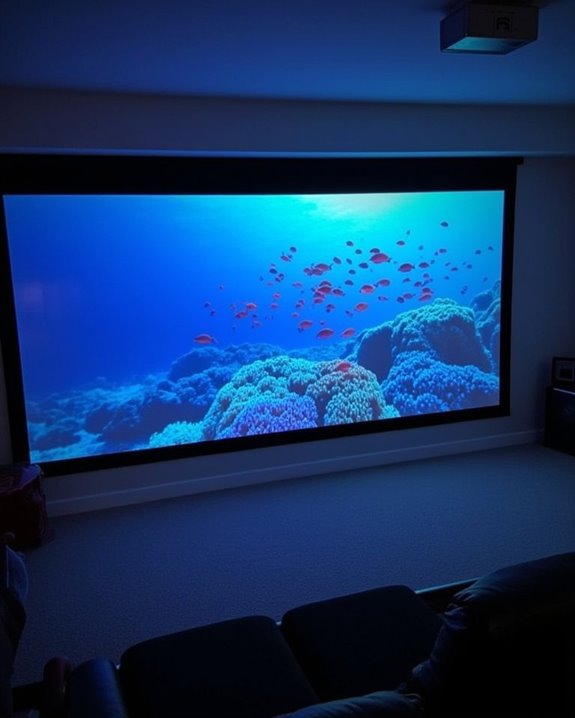
When evaluating projector paint for home theater screens, it’s essential to take into account how image quality, brightness, and contrast interact to shape your viewing experience, since each of these factors is directly influenced by the type of specialized paint you choose. High-performance paints, such as silver-based formulas, enhance pixel clarity and provide razor-sharp images, while rigid painted surfaces support high resolution without distortion. [The latest projector paints often include real precious metals or diamond coatings, which are designed to deliver premium visual and aesthetic effects for high-end home theater environments.] Ambient lighting can considerably impact both brightness and contrast, emphasizing the need for appropriate color calibration to maintain accurate colors. Consider these performance factors:
- Image Quality: Specialized paints enhance sharpness, depth, and format flexibility, outperforming traditional screens.
- Brightness: Paint color and screen gain affect peak brightness, with white paints typically offering higher brightness than grey ones.
- Contrast: Grey paints improve black levels and contrast, especially under moderate ambient lighting.
Projector Paint vs. Regular Wall Paint
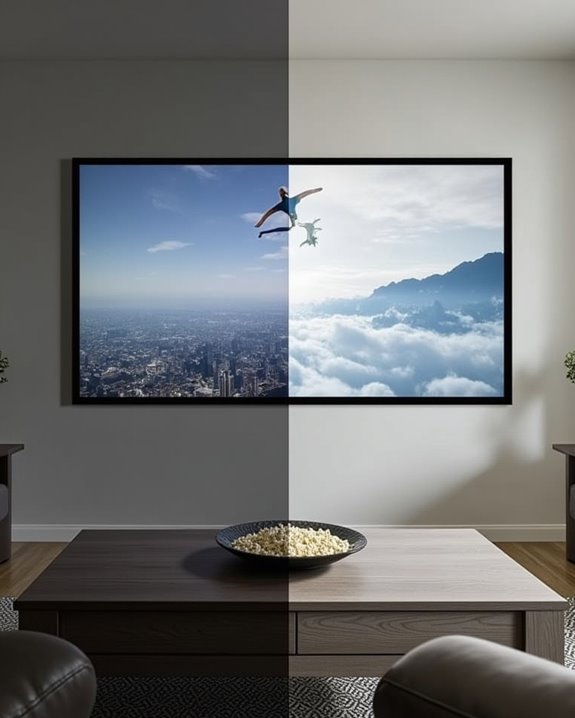
Because projector paint and regular wall paint serve different purposes, understanding their differences is essential for achieving ideal image quality in a home theater setup. Projector paint is specifically formulated to optimize color accuracy and reflectivity, ensuring the projected image remains vibrant and true to source material, while regular wall paint lacks these properties and can cause dull or distorted visuals. Surface texture is another critical factor—projector paint requires a smooth, even wall surface to minimize light scatter, whereas regular paint may leave subtle textures that disrupt image clarity. Although projector paint is more expensive, its performance in controlled lighting, ability to handle larger screen sizes, and its superior color accuracy make it a better choice for home theaters. Regular wall paint, by comparison, is strictly decorative. Most projector paints reflect less than 15% of projected light, which means they are engineered to manage ambient light and screen gain far better than standard paints.
Top Brands and Technological Advancements in Projector Paint
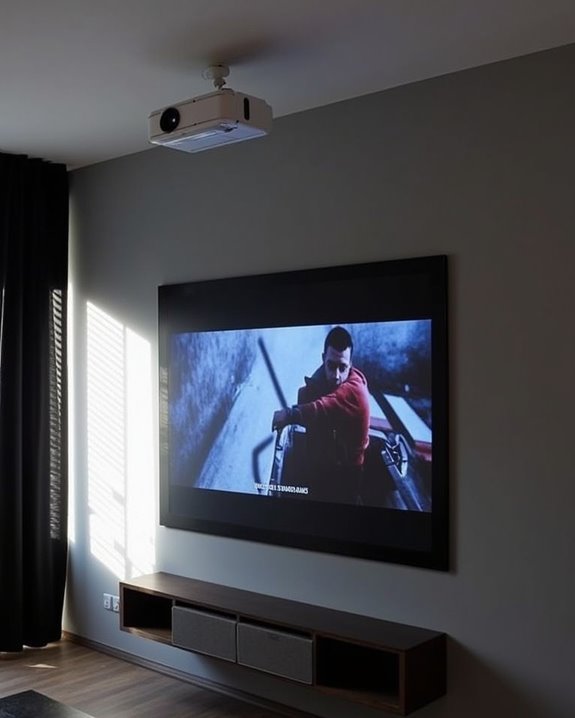
Selecting the right projector paint can have a significant impact on your home theater’s image quality, and recent innovations from leading brands have made it easier to accomplish professional-level results at home. Top brands like Paint On Screen, S1 Screen Plus, and Behr offer specialized formulas designed to maximize color accuracy and surface durability, supporting not only high gain for brighter images but also 4K UHD resolution clarity. These paints are engineered to guarantee true-to-life color reproduction, resist tinting, and withstand repeated use.
When comparing projector paints, it’s important to note that projector paints offer distinct features for brightness, contrast, and environment suitability, allowing you to tailor your choice to your specific viewing space and needs.
Here are three key advancements you’ll find:
- High reflectivity and gain for vivid, sharp visuals in various lighting.
- Advanced anti-glare and layering technologies to minimize reflections and enhance pixel definition.
- Durable, multipurpose surfaces that ensure long-lasting performance and easy maintenance.
Frequently Asked Questions
Is Projector Paint Safe for Children and Pets in the Home?
Up to 95% of projector paints are now certified non-toxic, so you’ll find child safety and pet safety prioritized. Always check for low VOCs and review safety sheets to verify your home stays a healthy environment.
Can Projector Paint Be Removed Without Damaging the Wall?
You can remove projector paint without causing wall damage if you’re careful. For paint removal, use a gentle remover, avoid abrasive tools, and always test your method first. Patience and proper prep help protect your wall’s surface.
How Does Projector Paint Perform in Outdoor Environments?
You’ll find projector paint excels outdoors—it’s weather resistant, resists cracking, and minimizes outdoor glare. You can use it day or night, and it offers easy maintenance, durability, and certified performance for vibrant, clear images outside.
What Surface Preparation Is Required Before Applying Projector Paint?
Before applying projector paint, you’ll need thorough wall cleaning to remove dust, grease, and imperfections. Sand the surface smooth, fill any holes, and finish with surface priming. Don’t skip these steps for the best projection quality.
Are There Color Options Available for Projector Paint Finishes?
You’ve got plenty of color options and finish varieties with projector paint. Choose from metallic finishes like Silver or Platinum, or go for matte, glossy, or even monochromatic schemes to match your room’s style and viewing needs.


